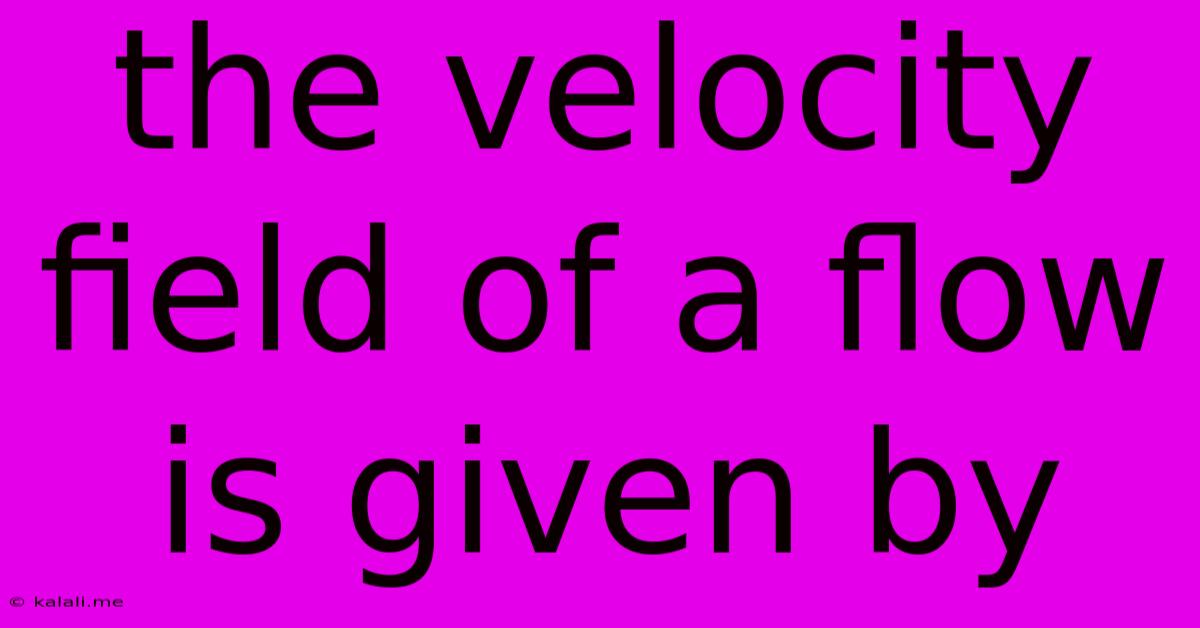The Velocity Field Of A Flow Is Given By
Kalali
Jun 15, 2025 · 4 min read

Table of Contents
Understanding and Visualizing the Velocity Field of a Flow
The velocity field of a flow provides a complete description of the motion of a fluid at every point in space and at every instant in time. Understanding this field is crucial in fluid mechanics, impacting analyses from simple pipe flow to complex weather patterns. This article will delve into the concept, its mathematical representation, and methods for visualization.
What is a Velocity Field?
Imagine a river. The water doesn't move at a uniform speed; it flows faster in the center, slower near the banks, and possibly with swirling eddies. The velocity field captures this complexity. It's a vector field, meaning at each point (x, y, z) in space, it assigns a vector v = (u, v, w) representing the velocity of the fluid at that location. u, v, and w represent the velocity components in the x, y, and z directions, respectively. These components are, in general, functions of both spatial coordinates and time (x, y, z, t).
Mathematical Representation:
The velocity field is typically represented mathematically as:
v(x, y, z, t) = u(x, y, z, t)i + v(x, y, z, t)j + w(x, y, z, t)k
where:
- v(x, y, z, t) is the velocity vector at point (x, y, z) and time t.
- u(x, y, z, t), v(x, y, z, t), w(x, y, z, t) are the velocity components along the x, y, and z axes, respectively.
- i, j, k are the unit vectors along the x, y, and z axes.
This equation highlights the dependency of the velocity on both space and time. In steady flows, the velocity is independent of time (∂v/∂t = 0), simplifying the analysis considerably.
Types of Velocity Fields:
Several classifications exist based on the characteristics of the velocity field:
- Steady vs. Unsteady: Steady flows have a velocity field that doesn't change with time. Unsteady flows exhibit time-dependent velocity fields.
- Uniform vs. Non-Uniform: A uniform flow has a constant velocity throughout the flow field. Non-uniform flows have varying velocities.
- One-Dimensional, Two-Dimensional, Three-Dimensional: This classification refers to the number of spatial dimensions required to describe the velocity field. For example, flow in a long straight pipe can often be approximated as one-dimensional.
- Rotational vs. Irrotational: A rotational flow has vorticity (local rotation), while an irrotational flow does not. Vorticity is mathematically defined as the curl of the velocity field (∇ x v).
- Compressible vs. Incompressible: This refers to whether the density of the fluid changes significantly during the flow. Incompressible flows are simpler to analyze.
Visualizing the Velocity Field:
Visualizing the velocity field is crucial for understanding the flow behavior. Several techniques exist:
- Streamlines: These lines are tangent to the velocity vector at every point. They represent the path a massless fluid particle would follow.
- Streamtubes: These are bundles of streamlines, representing a flow of a certain mass.
- Pathlines: These trace the actual path of a fluid particle over time.
- Streaklines: These show the locus of all fluid particles that have passed through a particular point.
- Vector Plots: These directly represent the velocity vector at various points in the flow field. This can be effective for small flow domains but can become cluttered in large ones.
- Contour Plots: These display contours of constant velocity magnitude or other flow properties like pressure or vorticity.
The choice of visualization technique depends on the specific characteristics of the flow and the information one wants to highlight.
Applications of Understanding Velocity Fields:
Understanding and analyzing velocity fields is crucial in numerous applications, including:
- Aerodynamics: Designing efficient aircraft and predicting aerodynamic forces.
- Hydrodynamics: Analyzing ship design, river flows, and ocean currents.
- Meteorology: Modeling weather patterns and predicting atmospheric phenomena.
- Medical Engineering: Simulating blood flow in arteries and veins.
- Chemical Engineering: Designing efficient reactors and optimizing mixing processes.
By combining mathematical descriptions and effective visualization techniques, engineers and scientists can gain profound insights into the complex behavior of fluid flows, ultimately leading to better designs and more accurate predictions. The study of velocity fields remains a fundamental aspect of fluid mechanics, constantly evolving with advancements in computational fluid dynamics (CFD) and visualization tools.
Latest Posts
Latest Posts
-
Which Of The Following Statements About Development Is True
Jun 16, 2025
-
What Is The Lcm Of 14 And 18
Jun 16, 2025
-
Kelvin Is The Si Unit For Which Physical Quantity
Jun 16, 2025
-
Anything Which Disrupts The Communication Process Is Called
Jun 16, 2025
-
Where Does Meiosis Occur In A Flowering Plant
Jun 16, 2025
Related Post
Thank you for visiting our website which covers about The Velocity Field Of A Flow Is Given By . We hope the information provided has been useful to you. Feel free to contact us if you have any questions or need further assistance. See you next time and don't miss to bookmark.